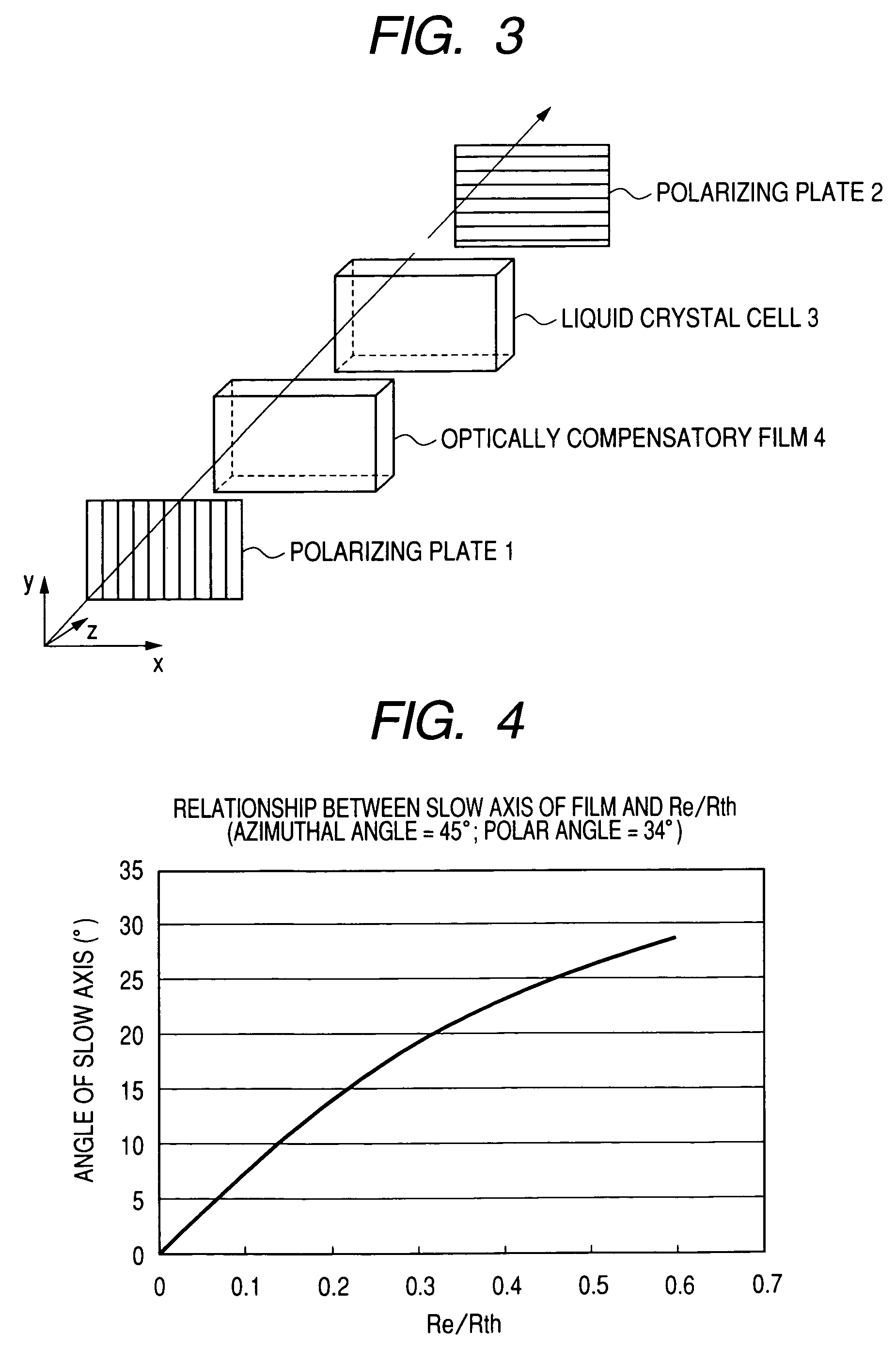Optical resin film and polarizing film and liquid crystal display device using the same
a technology of optical resin film and polarizing plate, which is applied in the direction of optics, polarising elements, instruments, etc., can solve the problems of severe requirements for viewing angle dependence of liquid crystal display device, and the inability to meet requirements, and achieve high contrast ratio
- Summary
- Abstract
- Description
- Claims
- Application Information
AI Technical Summary
Benefits of technology
Problems solved by technology
Method used
Image
Examples
example 1
(Preparation of Cellulose Acylate Film)
[0476]A mixture obtained by uniformly stirring 100 parts by mass of cellulose made from linter pulp and glacial acetic acid in an amount of 100 parts by mass based on the mass of cellulose was added to a chilled mixture of 245 parts by mass of acetic anhydride, 365 parts by mass of acetic acid and 15 parts by mass of sulfuric acid as a catalyst in a reaction vessel where they were then subjected to acetylation at 47° C. for 60 minutes. During the termination of acetylation reaction, 45.5 parts by mass of an aqueous solution of magnesium acetate (30 mass-%) for hydrolyzation and neutralization was added to the reaction mixture so that the excess acetic anhydride and sulfuric acid were subjected to hydrolyzation and neutralization, respectively. Thereafter, to the reaction solution was added about 12.8 parts by mass of an aqueous solution of magnesium acetate (30 mass-%) for ripening while being heated to 60° C. Thereafter, to the reaction soluti...
example 2
[0497]A film was prepared in the same manner as in Example 1 except that the film thickness was changed as set forth in Table 2. A liquid crystal television was prepared from the film in the same manner as in Example 1. The liquid crystal television thus prepared was then evaluated for color shift under varying environmental conditions set forth in Table 2. In some detail, the liquid crystal TV was allowed to stand under the environmental conditions (temperature / relative humidity) set forth in Table 2 for 12 hours, and then measured for color shift. The results are set forth in Table 2 below.
[0498]
TABLE 2Example 2[Re[Re(450) / (650) / RthRth(450)] / (650)] / ReRe[Re[Re(450) / (650) / (550) / (550) / FilmColor shiftFilmReReReRthRthRthReReRthRththickness(25° C.)No.(450)(550)(650)(450)(550)(650)(550)(550)(550)](550)](μm)60%10%80%Remarks215562691751701650.891.110.861.157010010398Invent.225562691751701650.891.110.861.15100115125123Compar.235562691751701650.891.110.861.155010110399Invent.Color shift is r...
example 3
[0500]A 1.0 N solution of potassium hydroxide (solvent: water / isopropyl alcohol / propylene glycol=69.2 parts by mass / 15 parts by mass / 15.8 parts by mass) was spread over the film prepared in Example 1 on the band side thereof at a rate of 10 cc / m2. The coated film was then kept at about 40° C. for 30 seconds. The alkaline solution was scratched off the coat film. The coated film was washed with purified water. Water droplets were then blown off the coated film with air from an air knife. Thereafter, the coated film was dried at 100° C. for 15 seconds. The film thus processed was then measured for contact angle with respect to purified water. The result was 42°.
(Preparation of Alignment Film)
[0501]A alignment film coating solution having the following formulation was spread over each of Film Nos. 1 to 3 at a rate of 28 ml / m2 using a #16 wire bar coater. The coated films were each dried with 60° C. hot air for 60 seconds and then with 90° C. hot air for 150 seconds to prepare an alignm...
PUM
| Property | Measurement | Unit |
|---|---|---|
| thickness | aaaaa | aaaaa |
| wavelength ranges | aaaaa | aaaaa |
| wavelength ranges | aaaaa | aaaaa |
Abstract
Description
Claims
Application Information
 Login to View More
Login to View More - R&D
- Intellectual Property
- Life Sciences
- Materials
- Tech Scout
- Unparalleled Data Quality
- Higher Quality Content
- 60% Fewer Hallucinations
Browse by: Latest US Patents, China's latest patents, Technical Efficacy Thesaurus, Application Domain, Technology Topic, Popular Technical Reports.
© 2025 PatSnap. All rights reserved.Legal|Privacy policy|Modern Slavery Act Transparency Statement|Sitemap|About US| Contact US: help@patsnap.com



